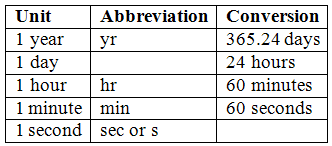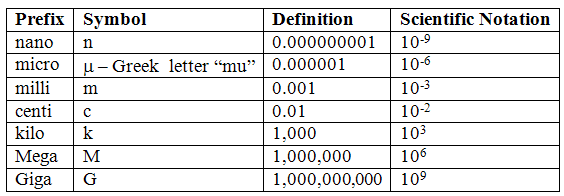1.1 Orientation
Video Lecture
-
•Orientation (47:18)
Post-Lecture Reading 1.1
-
•Astronomy Today, 8th Edition (Chaisson & McMillan)
-
•Astronomy Today, 7th Edition (Chaisson & McMillan)
-
•Astronomy Today, 6th Edition (Chaisson & McMillan)
Supplementary Notes
Units Review
Standard Units and Conversions
Standard Prefixes
-
•Example: 1 centimeter (or cm) = 0.01 meters (or 10–2 m)
-
•Example: 1 kilogram (or kg) = 1,000 grams (or 103 g)
-
•Note: Micrometers(or µm)are also called microns.
Unit Conversion
Example: How many nm in 1 km?
-
•Long answer:
1 km = 1 km × 1 × 1 = 1 km × 
103 m 1 km
×

109 nm 1 m 
= 1 km × 
103 m 1 km
×

109 nm 1 m 
= 1 × 103 × 109 nm = 1012 nm -
•Short answer:
1 km = 1 km × 
103 m 1 km
×

109 nm 1 m 
= 1012 nm -
•Bracket notation:1 km103 m
109 nm = 1012 nm 1 km1 m
Example: How many sec in 1 yr?
-
•Long answer:
1 yr = 1 yr × 1 × 1 × 1 × 1 = 1 yr × 
365.24 day 1 yr
×

24 hr 1 day
×

60 min 1 hr
×

60 sec 1 min 
= 1 yr × 
365.24 day 1 yr
×

24 hr 1 day
×

60 min 1 hr
×

60 sec 1 min 
= 1 × 365.24 × 24 × 60 × 60 sec = 31,556,736 sec -
•Short answer:
1 yr = 1 yr × 
365.24 day 1 yr
×

24 hr 1 day
×

60 min 1 hr
×

60 sec 1 min 
= 31,556,736 sec -
•Bracket notation:1 yr365.24 day24 hr60 min
60 sec = 31,556,736 sec 1 yr1 day24 hr60 min -
•Note: 31,556,736 happens to be approximatelyπ × 107,which is how I remember approximately how many seconds are in a year.
Example: How many arcsec in 1 deg?
-
•Long answer:
1 deg = 1 deg × 1 × 1 = 1 deg × 
60 arcmin 1 deg
×

60 arcsec 1 arcmin 
= 1 deg × 
60 arcmin 1 deg
×

60 arcsec 1 arcmin 
= 1 × 60 × 60 arcsec = 3,600 arcsec -
•Short answer:
1 deg = 1 deg × 
60 arcmin 1 deg
×

60 arcsec 1 arcmin 
= 3,600 arcsec -
•Bracket notation:1 deg60 arcmin
60 arcsec = 3,600 arcsec 1 deg1 arcmin -
•Bracket notation with symbol units:
1° 60' 60'' = 3,600'' 1° 1'
Lab Link
Material presented in this unit is related to material presented in Lab 1 of Astronomy 101 Laboratory: Our Place in Space. In Lab 1: Introduction to Skynet, we:-
•Observe astronomical objects with the PROMPT telescopes at the Cerro Tololo Inter-American Observatory in the Chilean Andes and with other telescopes around the world in the Skynet Robotic Telescope Network.
-
•Adjust the brightness and contrast levels of astronomical images to better view detail in them.
-
•Measure angles between and across objects in your images.
-
•Identify objects in your images that are moving through that part of the sky.
Video Lab Summaries
-
•Introduction to Skynet (36:26)
-
•Morehead Observatory (14:24)
-
•Remote Operations Room (11:43)
-
•PROMPT Telescope (5:25)
-
•Introduction to Afterglow (27:41)





